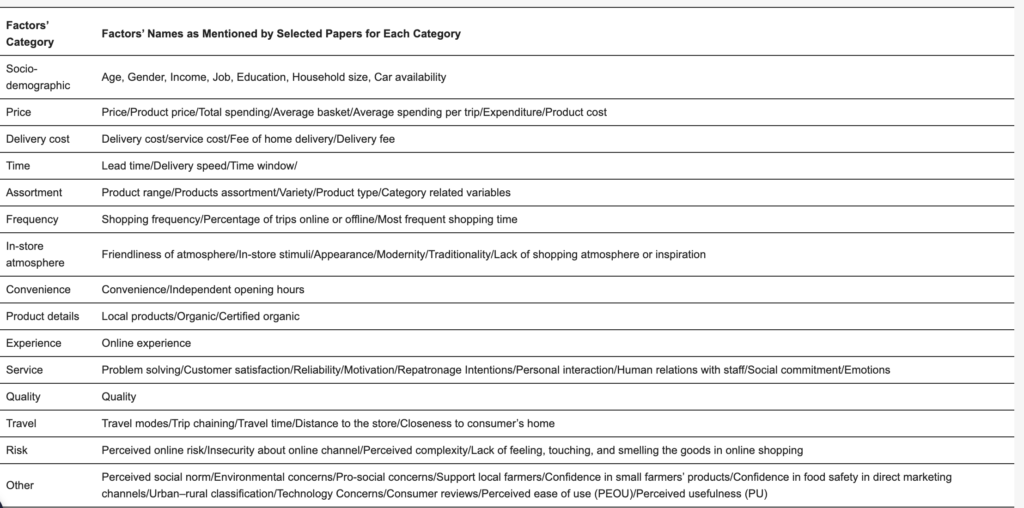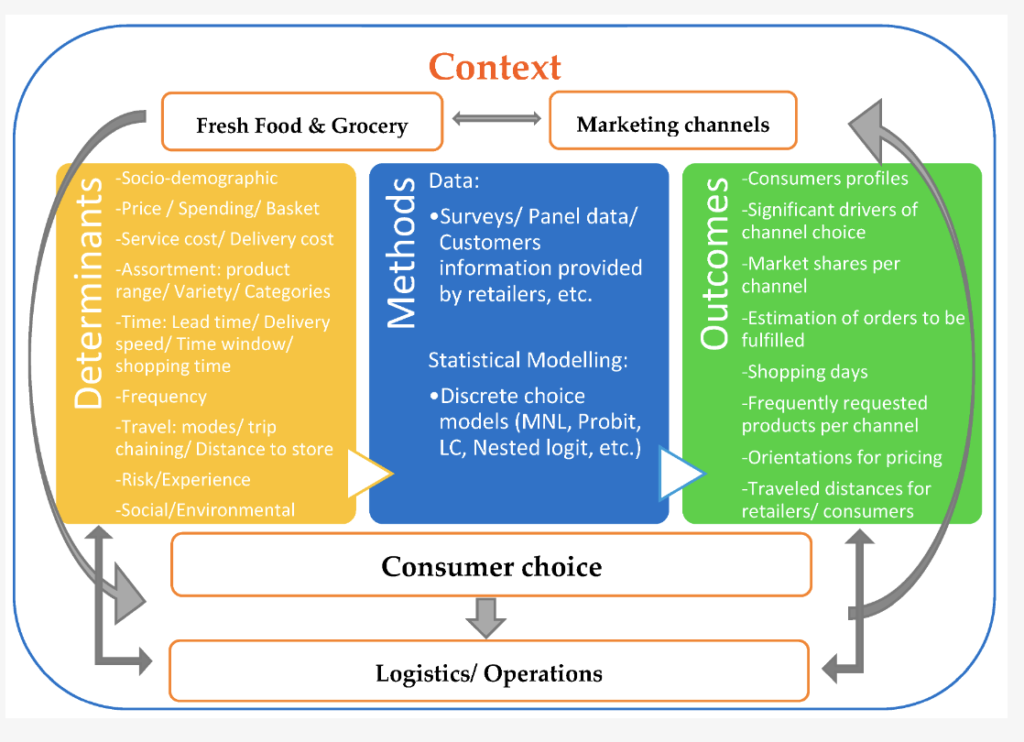The emergence of digitalization has led to the creation of various marketing channels. Consumers now have numerous options for shopping in the fresh food and grocery retail sector. Analyzing their behavior is crucial for retailers. A recent paper offers a cutting-edge review of existing studies on consumers’ channel choices when purchasing groceries.
The research
A systematic literature review (SLR) is performed following the Preferred Reporting Items for Systematic Review and Meta-Analysis (PRISMA) procedure, identifying 36 research papers published in the last decade.
The results present the principal methodologies the analyzed research papers adopted to address this topic and the various channels available to consumers. Other important outcomes of this review include the main variables that can affect consumer choice when deciding between the available channels and the limitations of the analyzed papers, along with suggestions for future research directions to address these limitations.
The paper discusses the essential effects of consumers’ channel choice on grocery retailers’ logistics and operation services. It also provides an integrative framework linking the influencing factors of consumer choice with outcomes directly impacting grocery retailers’ logistics services.

Logistics and operations issues
Examining consumers’ channel selection behavior is intricately linked to logistics and operational considerations. The logistics and operations perspective begins by considering consumer demand on each channel, product preferences, and attitudes. The diverse channels present in the grocery sector indicate variations in retailers’ processes. Often, a pure online player is responsible for managing the last-mile delivery. Alternatively, customers may collect their orders from a specified locker, where the e-grocer delivers them. In such instances, the e-grocer and the consumer share the last mile.
Assessing the proportion of consumers preferring locker delivery versus home delivery enables online grocery retailers to allocate financial, material, and human resources more efficiently. On the other hand, a brick-and-mortar grocery store, often classified as a pure offline player, is not burdened by last-mile considerations. However, this doesn’t imply that overall transportation costs for offline stores are necessarily lower than those for online stores. The latter may occasionally benefit from direct delivery options from a distribution center (DC) or warehouse.
On the flip side, traditional physical stores deliver goods from a distribution center (DC) or warehouse to the store, potentially incurring extra expenses tied to human resources, specialized materials, rent, and inventory-related costs. These costs are subject to fluctuations based on various factors. Transaction costs in online shopping may be lower than in offline shopping when dealing with larger baskets. Conversely, for smaller baskets, online shopping costs tend to be higher. The same study emphasizes the significance of channel choice decisions as a crucial factor for retailers in quantifying costs, particularly with variables associated with trips and product categories.
In the case of multichannel grocery retailers, operations are not interconnected. As a result, these retailers strive to optimize their operations, costs, and resources independently. On the contrary, incorporating multiple channels into an Omni-channel network involves a more intricate coordination of the operational services across different channels. This integration poses a significant challenge for retailers in terms of logistics services. Indeed, a pivotal concern is determining the optimal number of operational facilities required to minimize logistics costs.
The core of addressing challenges lies in retailers’ allocation policies. The availability of products across the primary channel categories (online and offline) can vary, contingent on the product type. Some studies indicate that bulky or heavy categories perform better online, while perishables are more commonly found in physical stores. Moreover, the preparation time for online orders varies based on the product category and the fulfillment type managers choose. Although a store-based e-fulfillment strategy may appear costly compared to DC e-fulfillment, strategic reallocation of orders to different time windows, stores, and delivery vehicles could yield significant savings. Other channels, such as the pick-up option, necessitate a distinct managerial approach.
Framework
The results presented in the researchers’ framework unveil the profiles of shoppers for each channel type. This framework also pinpoints crucial drivers influencing channel choices, often interconnected, based on numerous studies investigating these factors. In logistics services, a vital parameter to consider is the frequency of shopping days in online channels, facilitating the planning of deliveries and the allocation of workforce. Furthermore, obtaining generalizable insights into consumer trips and the distances covered by delivery vehicles can shed light on retailers’ logistics strategies.
The analysis underscores the significance of channel choice research in forecasting and planning for operational and logistics services. A key research focus involves contemplating a comprehensive business logistics model that encompasses inventory and capacity management, distribution network design, and the execution of delivery planning operations. Crucially, assessing how this model can deliver value to consumers while maintaining cost-effectiveness is necessary.
Given consumers’ expectations of swift deliveries and high service levels, efficient supply chain management becomes imperative for grocery retailers and fresh food providers. In this regard, streamlining the consolidation of last-mile delivery proves instrumental in helping retailers optimize resource allocation and reduce costs. The integration of on-time and real-time data, facilitated by new technologies, particularly data related to delivery trips and routing optimization, should be incorporated into research models to yield results that closely mirror real-world scenarios.

Environmental impact
The environmental impact of choosing between online and in-store grocery shopping varies significantly across different stages of the supply chain process. Distinctions arise in the last-mile delivery, where consumers handle physical channels, and in the replenishment, pre-sale, and sale phases.
Emissions generated at these stages differ notably between e-grocery and brick-and-mortar grocery retail, with online channels proving less environmentally harmful than offline ones. Recognizing food waste as energy waste, fostering awareness among logistics services and consumers, and implementing proper practices are key to reducing food waste. Therefore, gaining a deeper understanding of consumer behavior across various channels is a crucial factor influencing operations and logistics services, deserving consideration in research studies.
